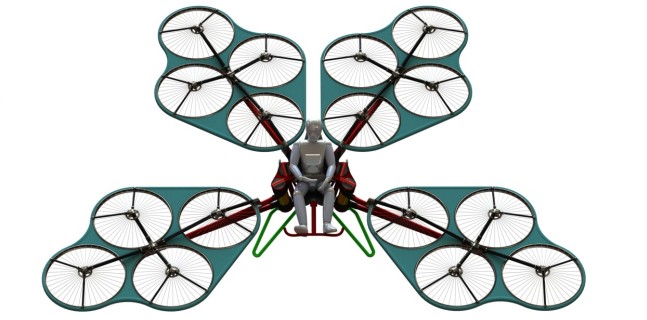The era of the personal flying machine is not here yet, but it seems a lot closer now that three guys from evolo have shown us how it can be done.They have scaled up the ubiquitous multicopter into an experimental manned flying platform. One can almost imagine the thrill of flying a domesticated version of this beast. It would be like having an airborne ATV.
Originally posted on SUAS News which has lots of news about Small Unmanned Aerial Systems.
German multicopter makes first manned flight.
By Gary Mortimer of SUAS News
It had to happen, and it was almost certainly going to be in Germany. Congratulations have to goto the team at e-volo they have possibly created a new manned flight platform, the first for many years.
The platform of choice for many sUAS operators, the multicopter has been super sized to such an extent that manned flight is now possible.
In their own words the team from e-volo have the following to say.
Simple flight for the average person would be a dream come to reality for us. In the next few years we would like to make more of these simple to fly devices available at an affordable price. The flyability of this device, the simple and straight forward piloting making the possibility of flight available to the average person is a goal that we strive towards.
The motors as well as control systems will be continuously worked on and developed to allow for extended flight time as well as a more efficient usage of available onboard energy.
Software regarding the 3D obstruction mapping will be improved.
Coming from an ultralight background, safety is written large in our books. Safety in flight will be developed with multiple concepts being hashed out and conceptuated for everyday use.
Optimization of energy usage in charging and durability in battery life is currently one of the largest problems in electrically powered transportation. The future is bright for the battery industry, as such we will strive to keep the newest and best available technology in our electrically powered devices.
A hybrid concept is in the works using a generated system be it gas, or other more efficient methods to power the device in flight.
A better flight time from on average 20-30 minutes is something we wish to improve. Hopefully the hybrid version will allow for better flight times of up to an hour or more.
The team point to a key advantage for electric flight.
This electrically driven system is quiet, clean and economically cost efficient. A one-hour flight would cost something near to 6 Euro for electricity. In addition, the device holds few parts, which could wear out, making maintenance intervals and cost low and far between.
The control firmware can be integrated with a sophisticated integrated GPS system or obstacle detection. As such, automated flight for predetermined points on a 3D map is possible. In addition to the relieving the pilot of strenuous navigational tasks, unmanned flight would be feasible similar to other devices (drones).
Having multiple motors means that the craft can keep flying should one or two engines fail. The flight controller will handle mismatched power automatically.
No doubt the military will now be knocking on the companies door to discuss a virtually silent single place helicopter that could be packed into a very small kit form for transportation.
There will be many regulatory hurdles to over come but excuse the pun, the team are off to a flying start.
Will the CAA let me fly one on my Helicopter licence I wonder 😉

